![]()
|
Winter at Grazer Kunstverein
7 December 2017 – 18 February 2018 Opening Reception: Thursday 7 December, 7pm New Commissions: Isabel Nolan Ola Vasiljeva On Display: Emily Mast Ruth E Lyons Fiston Mwanza Mujila Edward Clydesdale Thomson Céline Condorelli Chris Evans with Morten Norbye Halvorsen Fiona Hallinan Isabella Kohlhuber Isabel Nolan Adam Zagajewski On Reflection: Ernst Fischer The Necessity of Art by Ernst Fischer has served as the guiding leitmotif for the seasonal artistic programme of the Grazer Kunstverein throughout 2017. The late Fischer, an author, politician, and dedicated anti-fascist, believed that art held the key to perceiving, understanding, and ultimately changing the world around us. Thus the programme itself engages with Fischer’s conception of art as a living process of expressing the abstract in ways that ultimately shape reality, founded on the conviction that art has been, still is, and always will be necessary. As part of our Winter Season we proudly present two new exhibitions by Isabel Nolan and Ola Vasiljeva. These exhibitions are presented amidst the traces, developments and reconfigurations of the wider artistic programme, with an accumulation of works on display by Emily Mast (The Seed Eaters), Ruth E Lyons (Women’s Wear for Worldly Work), Fiston Mwanza Mujila (Le Fleuve dans le Ventre / Der Fluß im Bauch), Edward Clydesdale Thomson (The Coming Garden), Céline Condorelli (Things That Go Without Saying), Chris Evans and Morten Norbye Halvorsen (Jingle), Fiona Hallinan (Fink’s), Isabella Kohlhuber (Space for an Agreement), and Adam Zagajewski (We Know What Art Is). 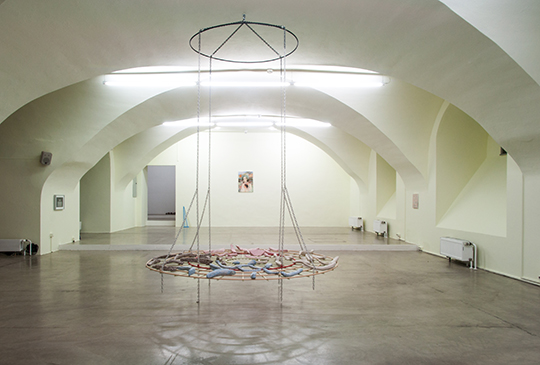 Isabel Nolan, installation view of Curling Up With Reality, Winter 2017, Grazer Kunstverein. Photography by Christine Winkler. 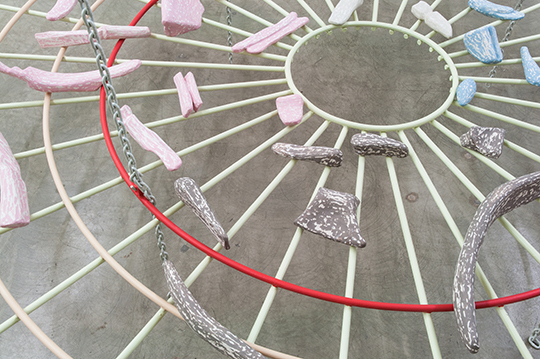 Isabel Nolan, detail view of Tomb (Memory Wheel), as part of Curling Up With Reality, Winter 2017, Grazer Kunstverein. Photography by Christine Winkler. Isabel Nolan
Curling Up With Reality, 2017
Isabel Nolan’s solo presentation of new and recent works reimagines the vaulted rooms of the Grazer Kunstverein as a crypt or secular chapel for the disgraced Dominican friar and cosmological theorist Giordano Bruno. Towards the end of the 16th century Bruno developed a mental memory system that he believed could encompass and order all knowledge of the universe. With (Tomb) Memory Wheel (2017), a suspended steel sculpture composed of concentric circles, upon which colourful, delicate, irregularly shaped bone-like objects rest, Nolan has reimagined an ossuary. This work is dedicated to Bruno’s memory system and his largely unacknowledged, anachronistic vision of an infinite universe where all matter, and so all people, were equally imbued with divinity and dignity. Throughout the show death and art are posited as powerful shapers of reality. A series of photographs focusing mostly on feet (human and animal, living and dead), man-made floors and pavements reveal the artist’s interest in looking down instead of up.
Whether she is imaging the lofty thoughts of unlikely philosophers, or observing the upturned soles of funerary sculptures, Nolan’s work examines how the universe is brought into meaning in the human mind, and how the intimate nature of direct contact with the world and physical lowness can unexpectedly arrest that process of understanding.
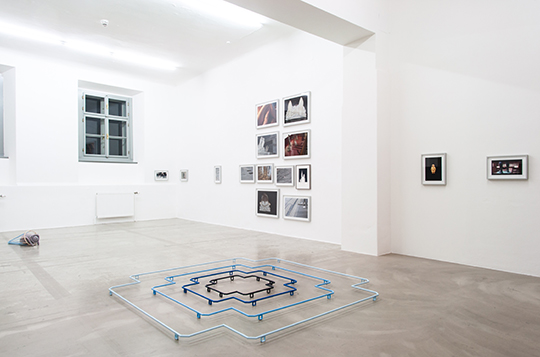 Isabel Nolan, installation view of Curling Up With Reality, Winter 2017, Grazer Kunstverein. Photography by Christine Winkler. 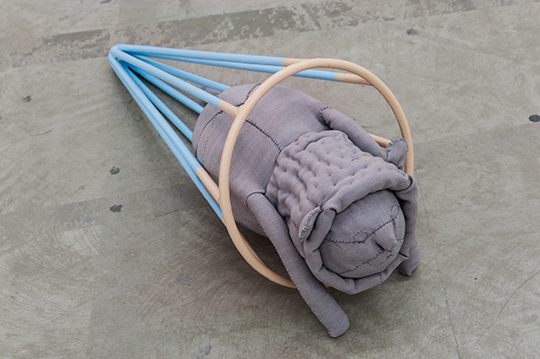 Isabel Nolan, installation view of Curling Up With Reality, Winter 2017, Grazer Kunstverein. Photography by Christine Winkler. Isabel Nolan (b. 1974, Dublin, Ireland) works with sculpture, textiles, photographs and text to describe or reveal moments (material, temporal, or otherwise) emerging from the fundamental human desire to find the world meaningful. Upcoming solo exhibitions include; San Antonio Museum of Art, Texas, and Kunstverein Langenhagen (2018). Recent solo exhibitions include Another View From Nowhen, London Mithraeum Bloomberg SPACE, Calling on Gravity at the Douglas Hyde Gallery, Dublin, and The weakened eye of day, which toured from the Irish Museum of Modern Art, Dublin (2014) to Mercer Union, Toronto and CAG, Vancouver (2016); A Thing Is Mostly Space, Launch Pad New York (2015); The Model, Sligo (2011), travelling to the Musée d’art moderne de Saint Etienne, France (2012); The Return Gallery, Goethe Institute, Dublin (2012–13); Gallery 2, Douglas Hyde Gallery, Dublin (2008) and Project Arts Centre, Dublin (2005). 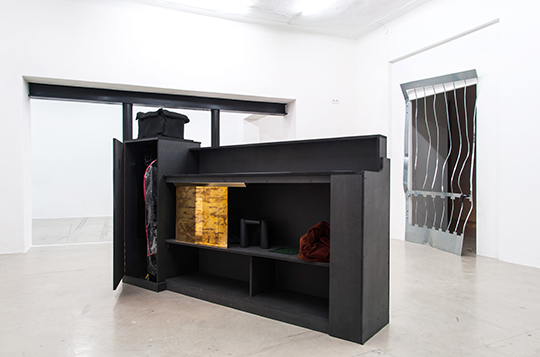 Ola Vasiljeva, installation view of The Decline of the Showpieces, Winter 2017, Grazer Kunstverein. Photography by Christine Winkler. 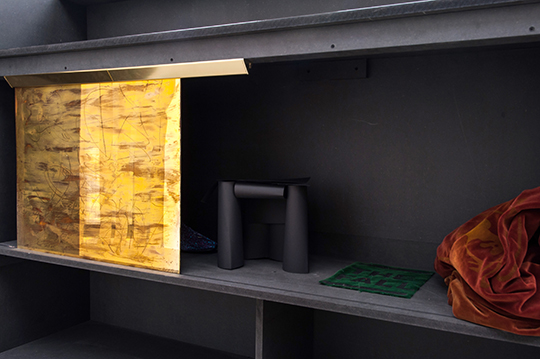 Ola Vasiljeva, detail view of Mr. Krop is not at home, Winter 2017, Grazer Kunstverein. Photography by Christine Winkler. Ola Vasiljeva
The Decline of the Showpieces, 2017
Ola Vasiljeva’s work tells stories. Stories that belong to no single entity, but which unfold gently through objects. While walking one day in Graz, the artist encountered an enormous boarded-up 16th century building on Kaiser Franz Josef Kai. Falling in love with the door and window grates that shelter the interior from the glare of passersby, she began to develop new sculptural works that would neither hide nor reveal themselves – objects that ‘look like’, but refuse to fully commit, sitting somewhere on the cusp of recognition. Vasiljeva speaks with materials through strong lines, exaggerated features and rude shapes, but it’s the magic she conjures in encapsulating what’s absent that makes her work really sing. As part of our Winter Season the artist stages an arrangement of recent and newly produced work, to create a series of imaginary thresholds that act as guardians between one moment and the next. One of the artist’s works can also be seen in the window of the house whose encounter first inspired her assembly of objects for this exhibition. The work can be seen from the street, at 36 Kaiser Franz Josef Kai, and is kindly facilitated by the landlord. 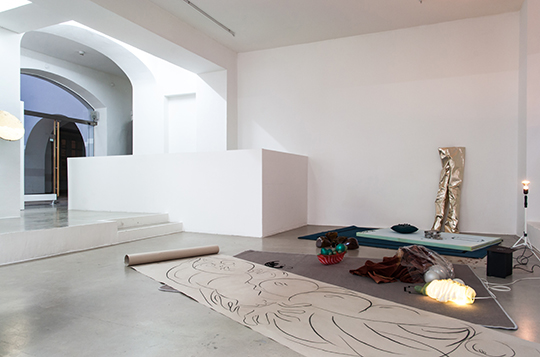 Ola Vasiljeva, installation view of The Decline of the Showpieces, Winter 2017, Grazer Kunstverein. Photography by Christine Winkler. 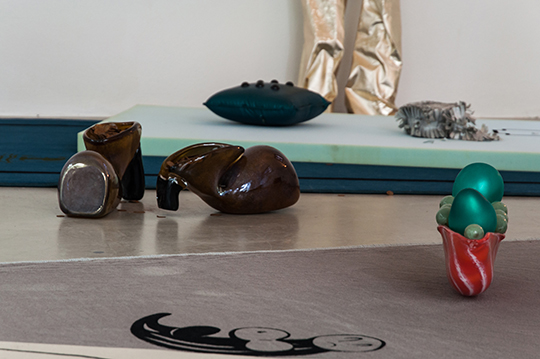 Ola Vasiljeva, installation view of The Decline of the Showpieces, Winter 2017, Grazer Kunstverein. Photography by Christine Winkler. Ola Vasiljeva (b. 1981, Ventspils, Latvia) borrows fragments from history and literature to create imaginary thresholds in which sculpture, drawing, video and found objects commingle on a level playing field. Based in Den Haag, Netherlands, Vasiljeva graduated from HKU and Rijksakademie van beeldende kunsten, Amsterdam in 2009. Upcoming exhibitions include; Qualcuno si è seduto sulla mia sedia, Quartz Studio, Torino, and Ola Vasiljeva and Matthew Lutz-Kinoy at Indipendenza, Rome (2018). Recent solo exhibitions include: The Dong with the Luminous Nose, Galerie Fons Welters, Amsterdam 2017; Gold Is the Metal With the Broadest Shoulders, Supportico Lopez, Berlin, 2017; Zefiro Torna, Passarelle CAC, Brest, 2017; You’ve got beautiful stairs, you know, Kunstverein München, Munich, 2016; Coeurtregetour, Galerie Antoine Levi, Paris, 2016; En Rachâchant, Vleeshal Markt, Middelburg, 2015; The Limp of A Letter, BOZAR, Brussels, 2015; and Prix de Rome, De Appel, Amsterdam, 2013. Vasiljeva is the founder of OAOA (The Oceans Academy of Art), a hybrid art collective which functions as a platform for ideas about art, culture and the representation thereof. She is represented by Antoine Levi, Paris and Supportico Lopez, Berlin.  Ola Vasiljeva, Who Sat On My Chair?, Winter 2017, Grazer Kunstverein. Photography by Christine Winkler.  Ola Vasiljeva, installation view of The Decline of the Showpieces, Winter 2017, Grazer Kunstverein. Photography by Christine Winkler. Ernst Fischer
The Necessity of Art – A Marxist Approach, 1959
Ernst Fischer was born in Bohemian Komotau in 1899. He died in 1972 at the house of the three Feuerlöscher sisters, now known as Prenning’s Garten in Deutschfeistritz, just outside of Graz. During his early life Fischer studied philosophy in Graz, before joining the staff of the Arbeiter-Zeitung, where he remained until 1934. Thereafter he became a member of the Communist Party, and in 1945 he was instrumental in establishing a provincial government in Austria, where he briefly played the role of Minister of Education. Fischer was also founder and editor-in-chief of Neues Österreich. From the late 1950s onwards he engaged himself more deeply in the literary world, producing books and plays reflecting on the importance of culture for the class struggle, his earlier experiences as an exile and freedom fighter, and the necessity of art. In 1959 Fischer first published his book The Necessity of Art. In it, he explored why art matters despite the trauma and hardship of everyday life. Fischer was a virulent opponent of fascism and the Nazis, fighting first through socialism, then through communism, and finally retreating into arts and culture as a space of reimagining and resistance. As the spirit guide throughout 2017, Fischer’s writings, thoughts and influence find fresh resonance by motivating the artistic programme and inspiring new commissions and artworks. |

